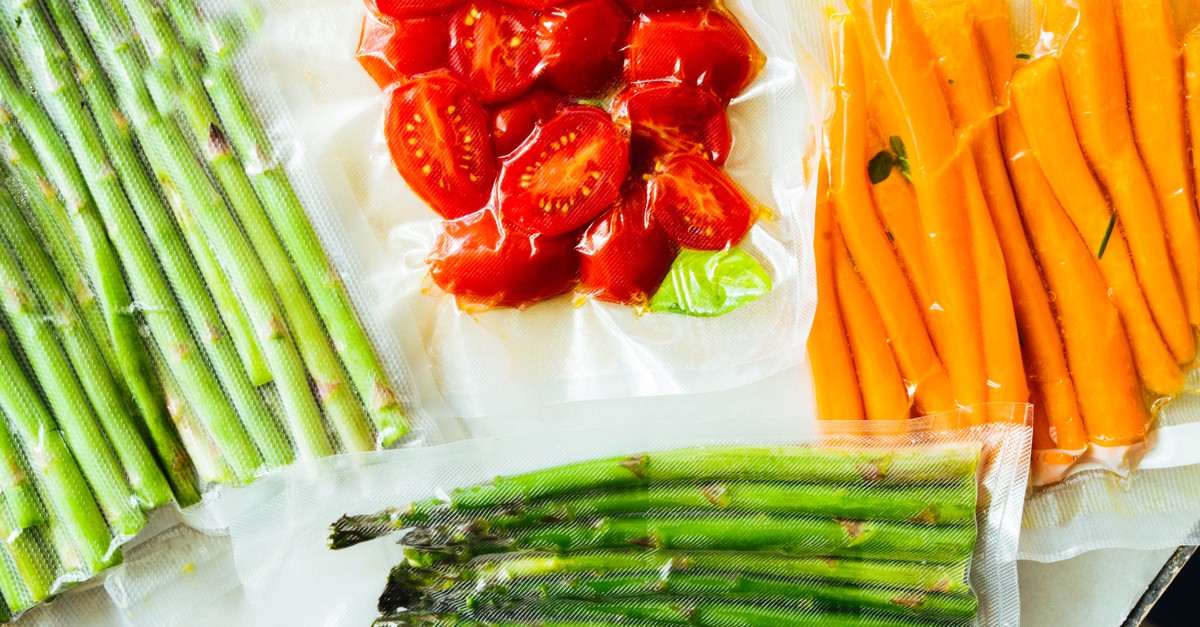The Struggle:
Still on the topic of sous vide this week. But if you haven’t read last week’s article we suggest you do so here. This week it will be slightly different as we are covering everything plant-based. Fruits, vegetables, herbs, and spices react very differently from the proteins and fats we covered last week. When I used to give lectures about modern cooking techniques, one of the most confusing things to covey was how differently vegetables react compared to proteins. Vegetables seem to be more delicate than hearty meats. When in fact it is the complete opposite. But how do you cook vegetables in an immersion circulator.
“But how do you cook vegetables in an immersion circulator?”
Break it Down Again…
So to start from the top. First thing you need to do is place something into a vacuum sealed bag. Food savers work okay for cooking sous vide, but nothing tops a quality vacuum sealer. When you add fruits vegetables to a vacuum sealed bag make sure they are not overlapping to prevent any misshapen product. The second thing to do is be aware that softer fruits and vegetables will change under vacuum. This is known as compression. As the atmospheric pressure of the vacuum sealer raises the air that is trapped between the cells of the food is sucked out. As the bag is sealed and the pressure is returned to normal the intercellular airspace is destroyed and the food becomes more dense. The texture will change to be slightly more flexible than before and the appearance will become more transparent than before. This is also a great time to add amplify the taste of the foods, use this to increase the sweetness or acidity. As the chamber is pressurized the seasonings can be sucked into the foods.
Now that the food has been vacuum sealed. It is time to place the food in the water bath. Last week we talked about meats and how at low temperatures the food can be fully cooked. As well as over long periods of time you can make tough cuts, tender. At low temperatures fruits and vegetables will be unchanged. 160°F would be the higher range for meat would be too low to cook something like a carrot. A carrot vacuum sealed and cooked in an immersion circulator at 140°F would still be crunchy after 48 hours. At 160°F the flavor may begin to change but the texture will still be crunchy. This is because pectin does not degrade until it reaches 180-185°F. Pectin is the building block of cell walls in fruits and vegetables and until it is degraded the food will retain its texture. Once the food reaches the 180-185°F range it will start to break down. This is where you must do some testing to see where you prefer the texture of your vegetables. Also at this point we suggest treating this similar to blanching. Once removed the food should be placed into an ice bath to stop the cooking. If you are looking for vegetables to puree the food can be left in the bath for longer periods of time to fully breakdown. With purees we suggest going as high as 200°F to make the process quicker and more efficient. As with starches the main building block is amylopectin and it works the same way as pectin does. It is the building block for cell walls and doesn’t degrade until 185°F Although some of the starches can begin to swell and gelatinize at 140°F. This does not mean they will soften it just means they will purge some of their liquids. This works for vegetables that are any color but green. We all know what happens with green vegetables that are over cooked. The color turns to an unappetizing brown-green that people try to pass off as “olive green” but we all know it’s just a nice way to say over cooked. The best way to maintain that color is to set the chlorophyll by heating it to 158°F. A fun experiment to do is take a quart of water and a pound of spinach. Blend them together and strain the green water into a pot. Heat the water slowly and at 158°F on the dot the chlorophyll will set and float to the top. In green vegetables the same will happen although the chlorophyll will set in place within the vegetable. This works for any green vegetables. Just make sure to not leave the food in the bath for extended periods of time, as prolonged exposure to heat will degrade the color.
The next sous vide article we will cover will be on eggs and how absolutely amazing they truly are. One of the most complex items to cook in controlled temperature environments. But until then let us know what you have done with vegetables in your immersion circulator and as always feel free to Ask-A-Chef in the form below!



1 Comment.
Something that I’ve only recently learned about and started to apply is that pectin in apples will convert into a thermostable form if held between 140-160°F, and will then the apples will be more resistant to becoming mushy at higher temperatures. This can be applied by pre-cooking apples at this temperature before baking in an apple pie. Kenji has an article on this at SeriousEats. I’ve tried in in my apple pies, and it really works (and allows you to use less acidic apple varieties that tend to turn into apple sauce during baking).
https://sweets.seriouseats.com/2011/10/the-food-labs-apple-pie-part-2-how-to-make-perfect-apple-pie-filling.html